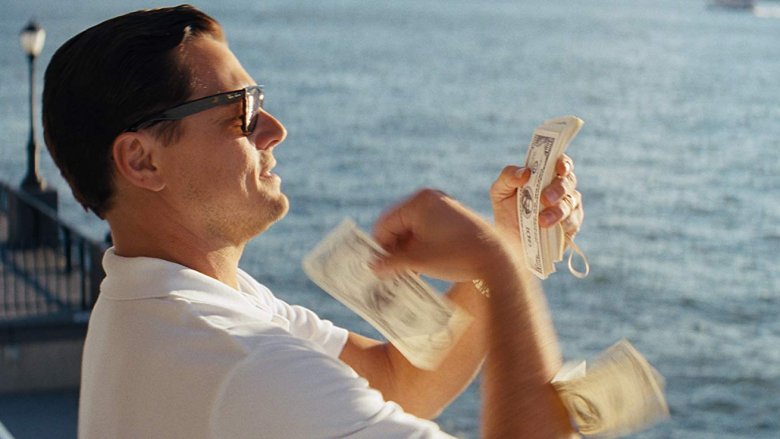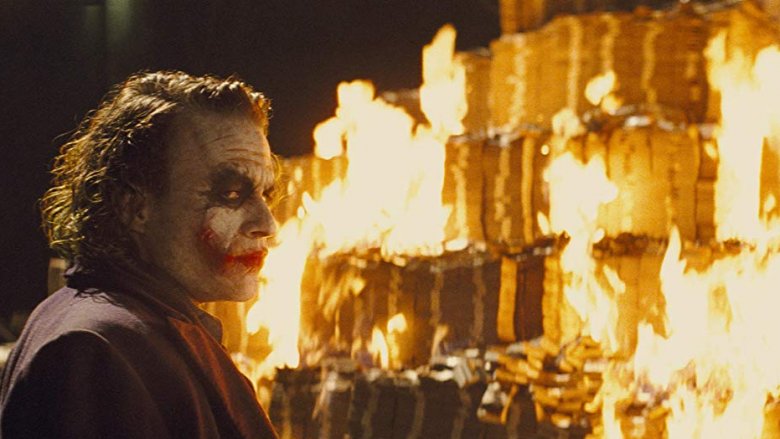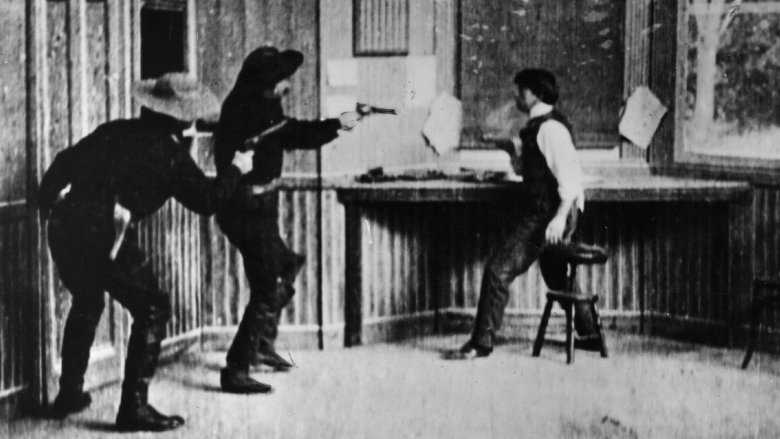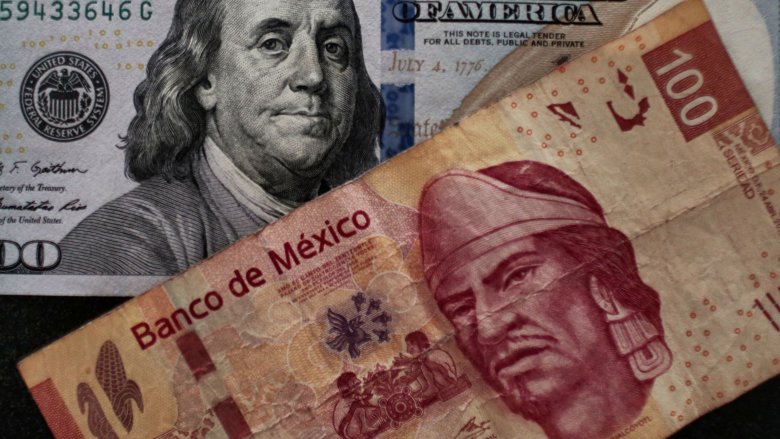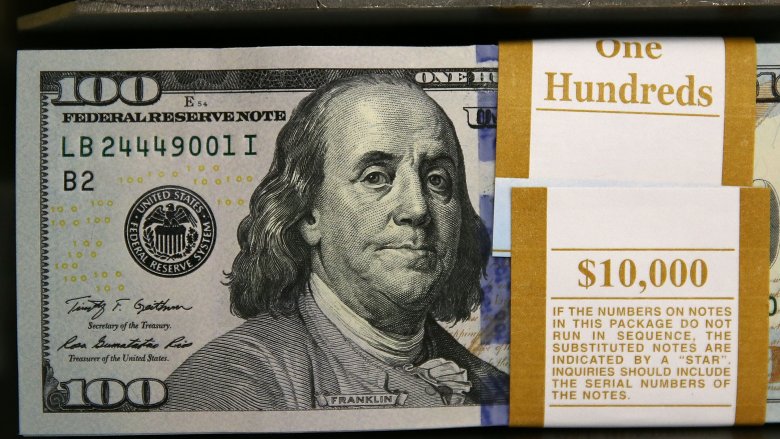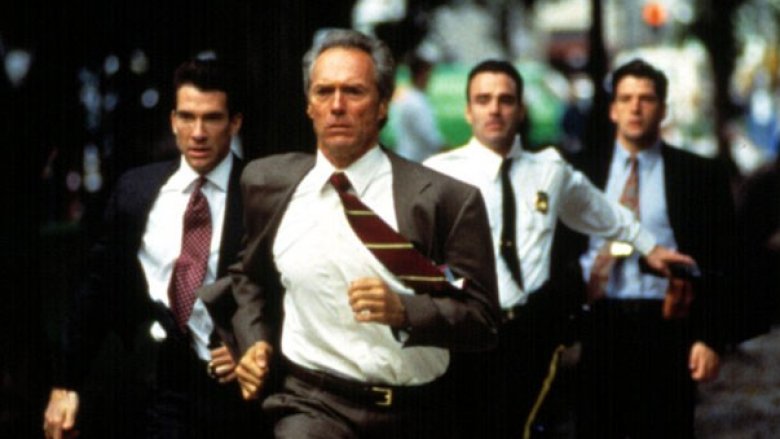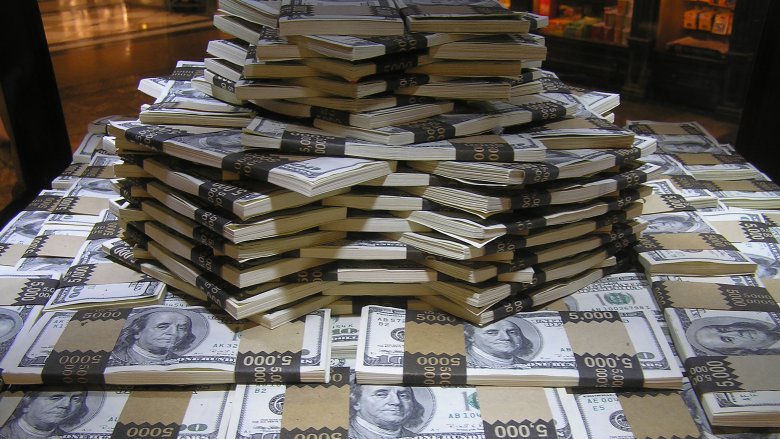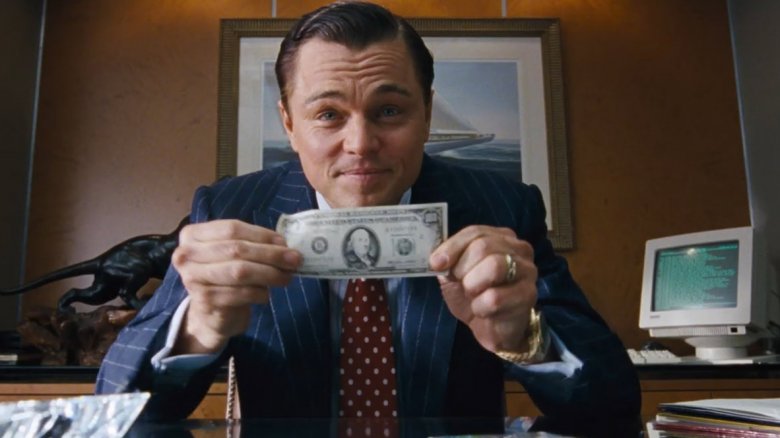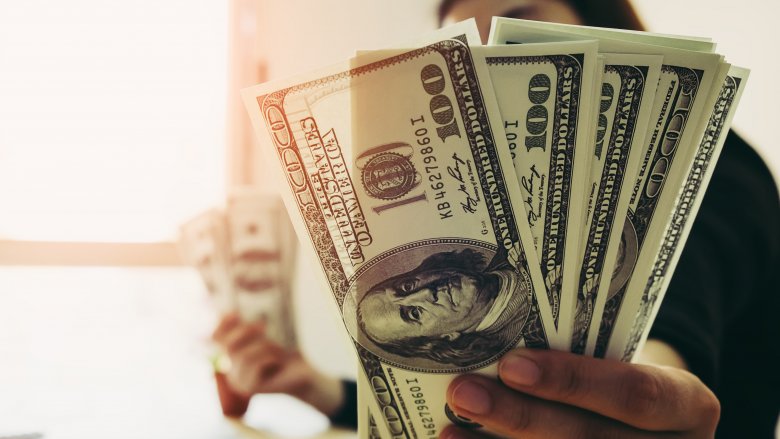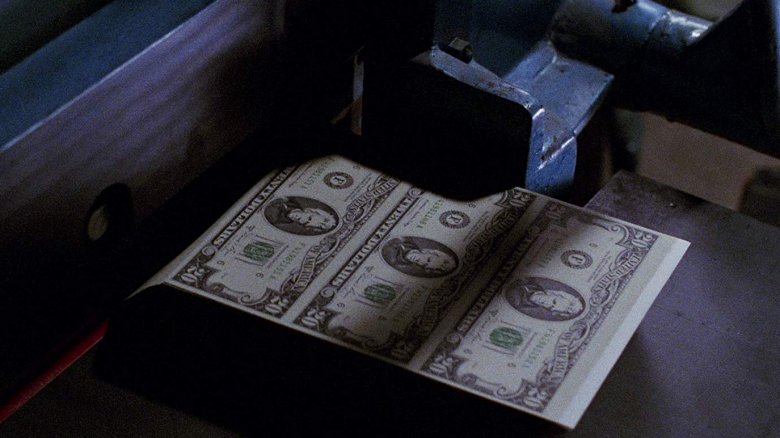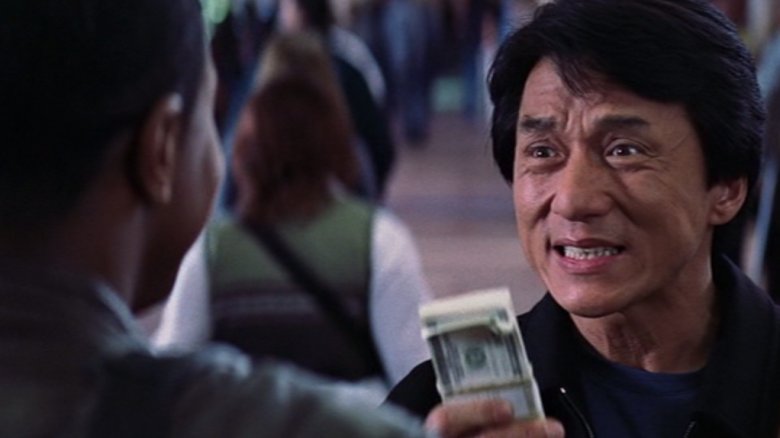The Truth About The Fake Money You See In Movies
While watching even our favorite movies and television series, it's easy to take certain things for granted — props, for instance. Props and prop masters are the unsung heroes behind movies, filling out the world of their stories with details both large and small. And while the bigger and flashier props like hard-hitting weapons, futuristic tech, and plot-centric "MacGuffins" (think the idol from the opening of Raiders of the Lost Ark or the Maltese Falcon from The Maltese Falcon) are often given their due appreciation, the seemingly mundane ones generally get overlooked.
One of the most prevalent of the latter throughout film and television is prop money. Whenever cash appears on screen, whether it be in small quantities glimpsed while a character buys groceries, or in huge stacks surveyed by a criminal antihero, what you're actually looking at is prop money.
The history of prop money is a fascinating one, from the earliest examples through to modern versions; from the rules and regulations that oversee its production, to controversies that have come from cast and crew members trying to pass it off as the real thing. Even when it comes to movie cash, the adage remains true: more money, more problems.
Liability
You may be wondering why filmmakers and producers go through the trouble of using fake money, when it would seem way easier to simply use real money, at least during scenes in which actors only have to handle a small amount of cash. There are actually a number of rules and regulations regarding how prop money is made, distributed, and used, so why not just avoid the logistical headache altogether?
The fact is, using real money is an even bigger logistical headache. Studio-backed productions have to account for everything on set, so throwing real money into the mix just makes the crew's job harder. This is even more true for scenes depicting larger sums in visually impressive stacks, especially in scenes where it's destroyed (in famous examples such as Lethal Weapon 2 and The Dark Knight).
However, when it comes to the depiction of legal tender in movies, this was not always the case.
Earliest examples
Money has been appearing in movies from the earliest origins of the medium. As he outlines in his book on the subject of currency in film, Show Me the Money: The Standard Catalog of Motion Picture, Television, Stage, and Advertising Prop Money, author and historian Fred Reed cites the first such example of cash showing up onscreen as Thomas Edison's 1895 kinetoscope film "Cockfight," about, well, cockfighting.
It would show up again a few years down the line, in 1903's groundbreaking narrative short film, "The Great Train Robbery." As in "Cockfight," the money shown during a famous stickup scene in "The Great Train Robbery" was real legal tender. Thanks to some seismic events in history, however, the use of real money in movies would soon become a thing of the past. Counterfeit cash was about to flood the country, necessitating the regulation of fake money used for entertainment purposes.
The history of fake money
The history of fake legal tender no doubt stretches across all of history, with fake gold coins having been minted in ancient times. In the United States, counterfeit cash has been around as long as the real stuff. There was a huge increase in counterfeiting crimes in the wake of the Civil War (it was estimated that anywhere between one-third to half of the money circulating throughout the country at the time was fake), and in order to combat this, federal laws were established. Among them was the banning of real money in photography.
Filmmakers during these early years tried to get around the problem by simply using Mexican cash (which had lost its value after the Mexican Revolution in 1920) as a stand-in. Over time, however, this practice fell by the wayside. Studios started printing their own prop money, which ran afoul of regulators for a variety of reasons. Fast forward to 1992, and a new law would set the terms under which movie money is still produced to this day.
The rules
The Counterfeit Detection Act of 1992 set three important restrictions on the printing of prop money for use in film and television (as well as other commercial and entertainment purposes such as advertising). The illustration on the currency must be "of a size less than three-fourths or more than one and one-half, in linear dimension, of each part of the item illustrated." Furthermore, bills may only be printed on one side. The most severe requirement states that every element of the design and printing process must be "destroyed and/or deleted or erased after their final use."
While the strict guidelines established by the law sought to streamline the process for filmmakers and studios (as well as the prop production companies that have taken over the manufacture of movie money in the time since), many argue that they are too restrictive, making it difficult to print bills convincing enough to fool the audience. Regardless, the law stands.
The regulators
You may be wondering just what branch of the government oversees cases involving counterfeiting, as well as the regulations for the legal printing of fake money. It may surprise you to learn that it's none other than the Internal Security Service, also known as the Secret Service. In fact, aside from securing the safety of important members of the government (most famously, the president and their family), this is the main duty of the Secret Service.
Of all the law enforcement agencies in the country, there are few more intimidating than the ISS, and you don't want to run afoul of them. Previously, when prop movie money has gone into circulation (more on that later), they've forced production companies to destroy their entire inventory, at a huge personal loss. This has resulted in prop companies having to rethink their process, all under the scrutinizing eye of the Secret Service.
Prop masters
As a result of the rules and regulations governing the production of prop money (to say nothing of the intricacy of the process), Hollywood studios no longer tend to make their own. Instead, they purchase fake money from third-party prop companies.
This is a steady business model that has been taken up by a number of craft specialists, including Independent Studio Services, based out of Sunland, California, as well as RJR Props, based in Atlanta (which, over the last decade or so has seen a boom in film and television production).
Chances are you've seen their work in dozens of films and television shows (as well as commercials and music videos). RJR has provided prop money for such notable examples as Wolf of Wall Street, Ozark, Lucky Logan, Good Morning America, and more. ISS, meanwhile, boasts a list of clients including the productions of Raiders of the Lost Ark, Beverly Hills 90210, 24, The Dark Knight, and (rather infamously, for reasons we'll explain later) Rush Hour 2.
The design process
The hardest part of prop masters' jobs when it comes to producing fake money is the design process. They are tasked with creating bills that look good enough to fool viewing audiences (or at least good enough to pass unnoticed), while not being so convincing that they could be passed off as legal tender in real life, all while adhering to the rules and regulations outlined by the law.
RJR Props created their own design: they start from scratch using plank paper that shares certain traits with the paper real money is printed on, such as color gradients (pink-yellow-pink and green-yellow-green). The words "Unreal Fake Currency Reserve" are written across the top left corner, and the signatures read "Ima Not Real" and "Not Real Currency." Other little changes are noticeable upon quick glance, including a drawing of the bill's featured Founding Father done from scratch and the words "United States" spelled with a W replacing the U.
The cost
Just because the money isn't real, that doesn't mean it's valueless — prop money doesn't come cheap. Unlike most other props, which are rented by producers, fake money has to be purchased. RJR sells fake hundreds at the range of $45-$65 per stack (depending on the quality of grade). Special "distress" bills (which look like they've been in circulation) will run you an extra $20.
The price is representative of the effort that goes into their craft. Prop money is designed from scratch (since it is illegal to base the design directly on the real thing) and made by hand. Individual bills are creased, wrinkled, even stained and burned, all in order to give them a quality of verisimilitude (and all done at the behest of discerning viewers who make up the small minority of most audiences). The entire process requires 15 to 20 people working together at a time.
Representation on screen
Given the logistical and legal complexity involved in producing and using prop money, you might think that filmmakers would want to stay away from it as a subject, but that's not the case. There are a number of films that center their plots around counterfeiting. Despite their sometimes adversarial relationship, these stories often portray Secret Service agents as their heroes.
Some of the more memorable examples include William Friedkin's neo-noir cult classic To Live and Die In L.A., which traces an ISS agent's obsessive pursuit of a master counterfeiter played by Willem Dafoe. There's also In the Line of Fire, which opens with an investigation led by Clint Eastwood's dogged Secret Service legend into a counterfeiting operation.
One has to assume that, when it came to these movies in particular, there was a large onus put on getting the fake money to look even more convincing, especially during the closeups of the goods.
Life imitating art
Just as art takes inspiration from life, so too does life often imitate art. The most infamous example of this is the case of Rush Hour 2 , the plot of which, ironically, revolved around an illegal counterfeiting operation. The film's climactic scene finds the aforementioned counterfeit money blown up at a casino, sending millions of dollars' worth of bills flying through the air and raining down on a crowd of excited bystanders.
The problem came when the extras who played the bystanders held onto that prop money and attempted to pass it off as real. Several businesses in the area reported the attempted use of movie money by customers, drawing the attention — and the wrath — of the Secret Service. They eventually forced Independent Studio Services, who had supplied the production with the prop money, to destroy their entire inventory.
While there have been other attempts to pass prop money off as real in the time since, this was the biggest example of such a case to date, and a reminder to prop manufacturers and studios alike that using fake money is always a risky venture. So, the next time you see an actor or musician throwing money in the air or counting off stacks of Benjamins, you might want to keep in mind that the illusion is, paradoxically, both more and less real than it may seem.
